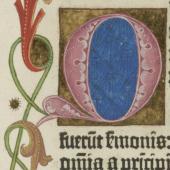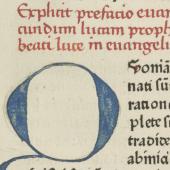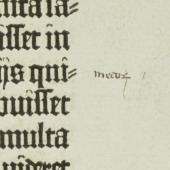‘Executed in the infancy of printing’
Private lives of print
In most cases fifteenth-century printers used a hand-written exemplar – the model text from which they set their books. Very occasionally, however, we find evidence of one printer using the work of another as his source material. Cambridge University Library’s copy of the first major book printed with moveable type, the Gutenberg Bible of around 1455, is unique in that it was acquired soon after publication by another printer and used by him as the example from which a later edition of the Bible was set.
In 1986, in a remarkable piece of scholarly detective work, the incunabulist Paul Needham noticed a series of distinctive and regular marginal marks appearing consistently throughout the Cambridge Gutenberg Bible. These crosses are printer’s marks, made by the Strassburg printer Heinrich Eggestein in the late 1460s. They show that Eggestein used this copy of the Gutenberg Bible as the model for his own edition of about 1469. Each cross in the margin represents the opening of a new page in the Eggestein Bible.


